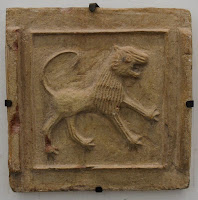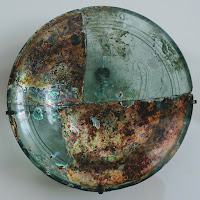 |
| Cafe des Delices looking down to the port |
We left Pantelleria after doing the weather analysis bit to death and were rewarded with exactly what we expected, 15 - 20 knot winds on the beam and a rocky 18 hours in a short sea. We gave Cap Bon on the north eastern tip of Tunisia a very wide berth, having noted the prevalence of wrecks on the chart, and found ourselves in the middle of the gulf of Tunis at sunrise. The marina at
Sidi Bou Said was unresponsive on the VHF and a silted entrance meant approaching without some understanding of the state of the dredged chanel was a dicey business. Thanks to Mohamed, who we met in Pantelleria, we had the harbour master’s personal phone number and he sorted out our arrival in no time at all. We were tucked into a quiet and very protected space and asked to visit the customs and marina office when we were ready. The police and customs could not have been friendlier or more efficient and I have to say it irks me how people write spurious stuff about them and how they are all on the take. Of course French is the other main language here and, once again, it rather helps to use it. A warmer reception we have seldom experienced and everyone we saw not only said hello but wished us ‘La bienvenue’.
We called Mohamed to thank him for arranging the berth and indicated we wanted to reciprocate in some form.
 |
| Zitouna Mosque |
It being Ramadan now, we were not sure of what to suggest. He in turn said it was no effort at all and suggested we join his family for a meal to break fast that evening. I have been in other muslim countries during Ramadan (notably Indonesia) so I had some inkling of what to expect. Nevertheless to be invited to a family dinner is hospitality squared.
We went into the medina and ate on the roof terrace of M’Rabet just near the Zitouna Mosque. We were served
brik a l’oeuf while we were bathed in the glorious scent of charcoal grilled lamb. It was delicious if a little rushed though as even the waiters and cooks pushed the pace, given that they could only eat once the guests had finished. Fasting is for the resolute, that is for certain. We returned to the relative calm of the marina, after battling through some mad traffic, and opened the fridge, I say no more...
 |
| The glorious Bardo Museum |
The next morning we made an excursion into Tunis, which would not be complete without a visit to the Bardo museum. So, shrugging off the offer of a limousine, we hopped into a local taxi that had obviously some wheel alignment issues. Our driver bravely kept his failing car on the road by coaxing the wheel constantly to port then immediately to starboard as if he had been schooled in yaw damping from an early age. We had pre-negotiated what seemed a fair price for the ride, but the settlement was not complete until he tried to levy the agreed fare on each of us. He good-naturedly laughed off his own attempt at a last gasp negotiation and we crossed a crazily busy road to enter the sanctuary of the museum. Only a few years ago though an atrocity played out here and it was all but a sanctuary in March 2015, but life moves on and even in the heightened security, a state of relative calm has been restored.
The Bardo is an expansive and overwhelming place that has a concentration of antiquity on display that takes some time to digest. It seems absurd too that one studies these breathtaking ancient artifacts, while walking on byzantine mosaic floors (in fact just about all the exhibits are unprotected), but it is a rare occurrence that we chose to savour and not question in this instance.
 |
| Baptism in style |
The span of millenia and cultures presented encompasses the Greek, Roman, early Christian, Jewish and Islamic worlds. It is perhaps not without small surprise that the state of preservation of some of these artifacts from the other two Abrahamic religions are in such pristine condition and presented with such respect. Clearly there is a barrier of prejudice a bit further to our north whose existence is not supported by the evidence on the ground here. Most of our journey over the past few years can be characterised as having had its roots in The Idea of South, which I have borrowed (antithetically) from Glenn Gould’s 1967 documentary ‘The Idea of North’ from his
Solitude Trilogy. As we venture to the southern reaches of Europe though, we are presented with the truth that there is a southern perimeter which has more to do with boundaries of preference and bias than any real borders. We sit most of the year in Sicily, which itself is on part of the African Mediterranean plate and whose history is entirely intertwined with the Maghreb. The reasons found in polite society, not to do such journeys are numerous, but in reality they are the only way one can dispel these myths. Flying to these places is not the same as us sailing along at 5 or 6 knots and tracking our progress painstakingly slowly between Europe and Africa. The sea is the same sea, fishing vessels large and small form a practically contiguous activity between the Christian north and Islamic South and their co-existence is as beneficial as it has ever been.
 |
| Ulysses |
Having reached saturation point we made our way to the tram and caught the number three to Tunis Marine. This same Alstom tram is to be found in many large EU cities, but usually rather less packed full of people. On the subsequent train journey to Sidi Bou Said we realised again why travelling in a limo or even taxi, hermetically seals you from experiencing these new surroundings first hand. One is warned about pickpockets, but in reality the people watching opportunity far outweighs the risk of losing a few Dinars, which we at no stage felt we were in danger of doing anyway. I am not sure that on the London Underground for instance you will see a youngster jumping up to give his seat to an old man, not me I hasten to add, or complete strangers trying to make a connection with tourists and each other through constant conversation in French, Tunisian, Arabic, English, and smatterings of German. My Tunisian is non-existent, of course, but I would bet a penny to a pound that Solitude is not a much used word here.
This bohemian village, Sidi Bou Said, sits on the top of hill above the port and presents a totally different picture and atmosphere to that of most of the capital, Tunis. It is very picturesque and its whitewashed walls, decorated (mostly blue) doors, Moucharabiehs, opulent bougainvilleas and fragrant jasmine, create an aesthetic and luminescence that has attracted artists for over a century.

Paul Klee, August Macke and Louis Moilliet visited here just over a hundred years ago and were captivated by its luminous quality - it has been billed as the visit that changed modern art. The sea breeze and prevailing winds mean that the air is clear and fresh providing relief from the soaring summer temperatures, which approach 50 degrees in August.
Whether or not the reputation as an artists’ hub is valid today is a matter for conjecture, but certainly production ceramics are on offer all over, making for an unnecessarily commercial sight.
After we met a man with a Falcon whose photogenic bird came at a price, we stopped at the Cafe de Delices, of Patrick Bruel fame. It stands at the top of
Les 365 Marches, which lead down to the port, and provides a glorious view of the gulf and sadly, probably, the promise of the North.
We decided to visit Tunisia on a whim, but leave in the certain knowledge that it was an essential thing to do. We head now to familiar waters again, but I am certain with a new perspective.
Our Current Location





 Paul Klee, August Macke and Louis Moilliet visited here just over a hundred years ago and were captivated by its luminous quality - it has been billed as the visit that changed modern art. The sea breeze and prevailing winds mean that the air is clear and fresh providing relief from the soaring summer temperatures, which approach 50 degrees in August.
Paul Klee, August Macke and Louis Moilliet visited here just over a hundred years ago and were captivated by its luminous quality - it has been billed as the visit that changed modern art. The sea breeze and prevailing winds mean that the air is clear and fresh providing relief from the soaring summer temperatures, which approach 50 degrees in August.









So eloquent, as always Peter. You should write a book. I whole-heartedly agree with your conclusion as to perspective. We found the same in Morocco to some extent. Wishing you both safe onward travels. A piu tardi!ciao!x
ReplyDelete